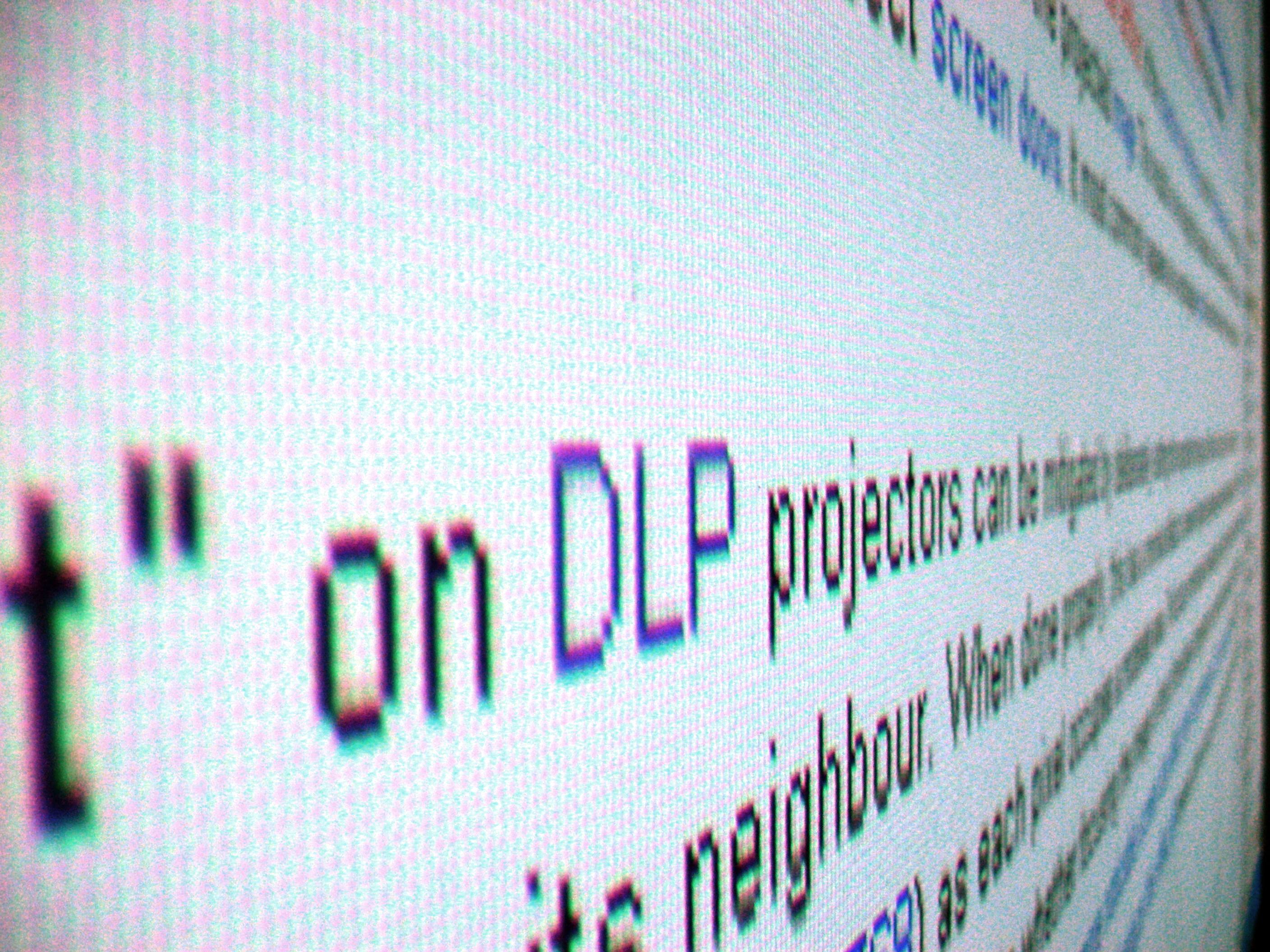|
CRT Projector
A CRT projector is a video projector that uses a small, high-brightness cathode ray tube (CRT) as the image generating element. The image is then focused and enlarged onto a screen using a lens kept in front of the CRT face. The first color CRT projectors came out in the early 1950s. Most modern CRT projectors are color and have three separate CRTs (instead of a single, color CRT), and their own lenses to achieve color images. The red, green and blue portions of the incoming video signal are processed and sent to the respective CRTs whose images are focused by their lenses to achieve the overall picture on the screen. Various designs have made it to production, including the "direct" CRT-lens design, and the Schmidt CRT, which employed a phosphor screen that illuminates a perforated spherical mirror, all within an evacuated cathode ray tube. The image in the Sinclair Microvision flat CRT is viewed from the same side of the phosphor struck by the electron beam. The other side of ... [...More Info...] [...Related Items...] OR: [Wikipedia] [Google] [Baidu] |
Standard-definition TV
Standard-definition television (SDTV, SD, often shortened to standard definition) is a television system which uses a resolution that is not considered to be either high or enhanced definition. "Standard" refers to it being the prevailing specification for broadcast (and later, cable) television in the mid- to late-20th century, and compatible with legacy analog broadcast systems. The two common SDTV signal types are 576i, with 576 interlaced lines of resolution, derived from the European-developed PAL and SECAM systems, and 480i based on the American NTSC system. Common SDTV refresh rates are 25, 29.97 and 30 frames per second. Both systems use a 4:3 aspect ratio. Standards that support digital SDTV broadcast include DVB, ATSC, and ISDB. The last two were originally developed for HDTV, but are also used for their ability to deliver multiple SD video and audio streams via multiplexing. In North America, digital SDTV is broadcast in the same 4:3 aspect ratio as NTSC ... [...More Info...] [...Related Items...] OR: [Wikipedia] [Google] [Baidu] |
Moiré Pattern
In mathematics, physics, and art, moiré patterns ( , , ) or moiré fringes are large-scale interference patterns that can be produced when an opaque ruled pattern with transparent gaps is overlaid on another similar pattern. For the moiré interference pattern to appear, the two patterns must not be completely identical, but rather displaced, rotated, or have slightly different pitch. Moiré patterns appear in many situations. In printing, the printed pattern of dots can interfere with the image. In television and digital photography, a pattern on an object being photographed can interfere with the shape of the light sensors to generate unwanted artifacts. They are also sometimes created deliberately – in micrometers they are used to amplify the effects of very small movements. In physics, its manifestation is wave interference such as that seen in the double-slit experiment and the beat phenomenon in acoustics. Etymology The term originates from '' moire'' (''moir� ... [...More Info...] [...Related Items...] OR: [Wikipedia] [Google] [Baidu] |
Scan Line
A scan line (also scanline) is one line, or row, in a raster scanning pattern, such as a line of video on a cathode ray tube (CRT) display of a television set or computer monitor. On CRT screens the horizontal scan lines are visually discernible, even when viewed from a distance, as alternating colored lines and black lines, especially when a progressive scan signal with below maximum vertical resolution is displayed. This is sometimes used today as a visual effect in computer graphics. The term is used, by analogy, for a single row of pixels in a raster graphics image. Scan lines are important in representations of image data, because many image file formats have special rules for data at the end of a scan line. For example, there may be a rule that each scan line starts on a particular boundary (such as a byte or word; see for example BMP file format). This means that even otherwise compatible raster data may need to be analyzed at the level of scan lines in order to convert ... [...More Info...] [...Related Items...] OR: [Wikipedia] [Google] [Baidu] |
240p
Low-definition television (LDTV) refers to TV systems that have a lower screen resolution than standard-definition TV systems. The term is usually used in reference to digital TV, in particular when broadcasting at the same (or similar) resolution as low-definition analog TV systems. Mobile DTV systems usually transmit in low definition, as do all slow-scan TV systems. Sources The Video CD format uses a progressive scan LDTV signal (352×240 or 352×288), which is half the vertical and horizontal resolution of full-bandwidth SDTV. However, most players will internally upscale VCD material to 480/576 lines for playback, as this is both more widely compatible and gives a better overall appearance. No motion information is lost due to this process, as VCD video is not high-motion and only plays back at 25 or 30 frames per second, and the resultant display is comparable to consumer-grade VHS video playback. For the first few years of its existence, YouTube offered only one, lo ... [...More Info...] [...Related Items...] OR: [Wikipedia] [Google] [Baidu] |
Screen-door Effect
The screen-door effect (SDE) is a visual artifact of displays, where the fine lines separating pixels (or subpixels) become visible in the displayed image. This can be seen in digital projector images and regular displays under magnification or at close range, but the increases in display resolutions have made this much less significant. More recently, the screen door effect has been an issue with virtual reality headsets and other head-mounted displays, because these are viewed at a much closer distance, and stretch a single display across a much wider field of view. SDE in projectors In LCD and DLP projectors, SDE can be seen because projector optics typically have significantly lower pixel density than the size of the image they project, enlarging these fine lines, which are much smaller than the pixels themselves, to be seen. This results in an image that appears as if viewed through a fine screen or mesh such as those used on anti-insect screen doors. The screen door ... [...More Info...] [...Related Items...] OR: [Wikipedia] [Google] [Baidu] |
Monochrome
A monochrome or monochromatic image, object or palette is composed of one color (or values of one color). Images using only shades of grey are called grayscale (typically digital) or black-and-white (typically analog). In physics, monochromatic light refers to electromagnetic radiation that contains a narrow band of wavelengths, which is a distinct concept. Application Of an image, the term monochrome is usually taken to mean the same as black and white or, more likely, grayscale, but may also be used to refer to other combinations containing only tones of a single color, such as green-and-white or green-and-red. It may also refer to sepia displaying tones from light tan to dark brown or cyanotype ("blueprint") images, and early photographic methods such as daguerreotypes, ambrotypes, and tintypes, each of which may be used to produce a monochromatic image. In computing, monochrome has two meanings: *it may mean having only one color which is either on or off (also known ... [...More Info...] [...Related Items...] OR: [Wikipedia] [Google] [Baidu] |
Rainbow Effect
Digital Light Processing (DLP) is a set of chipsets based on optical micro-electro-mechanical technology that uses a digital micromirror device. It was originally developed in 1987 by Larry Hornbeck of Texas Instruments. While the DLP imaging device was invented by Texas Instruments, the first DLP-based projector was introduced by Digital Projection Ltd in 1997. Digital Projection and Texas Instruments were both awarded Emmy Awards in 1998 for the DLP projector technology. DLP is used in a variety of display applications from traditional static displays to interactive displays and also non-traditional embedded applications including medical, security, and industrial uses. DLP technology is used in DLP front projectors (standalone projection units for classrooms and business primarily), DLP rear projection television sets, and digital signs. It is also used in about 85% of digital cinema projection, and in additive manufacturing as a light source in some printers to cure resin ... [...More Info...] [...Related Items...] OR: [Wikipedia] [Google] [Baidu] |
Computer Monitor
A computer monitor is an output device that displays information in pictorial or textual form. A discrete monitor comprises a visual display, support electronics, power supply, housing, electrical connectors, and external user controls. The display in modern monitors is typically an LCD with LED backlight, having by the 2010s replaced CCFL backlit LCDs. Before the mid- 2000s, most monitors used a CRT. Monitors are connected to the computer via DisplayPort, HDMI, USB-C, DVI, VGA, or other proprietary connectors and signals. Originally, computer monitors were used for data processing while television sets were used for video. From the 1980s onward, computers (and their monitors) have been used for both data processing and video, while televisions have implemented some computer functionality. In the 2000s, the typical display aspect ratio of both televisions and computer monitors has changed from 4:3 to 16:9. Modern computer monitors are mostly interchangeable with televi ... [...More Info...] [...Related Items...] OR: [Wikipedia] [Google] [Baidu] |
Downscaling
Downscaling is any procedure to infer high-resolution information from low-resolution variables. This technique is based on dynamical or statistical approaches commonly used in several disciplines, especially meteorology, climatology and remote sensing. The term ''downscaling'' usually refers to an increase in spatial resolution, but it is often also used for temporal resolution. Meteorology and climatology Global Climate Models (GCMs) used for climate studies and climate projections are typically run at spatial resolutions of the order of 150 to 200 km and are limited in their ability to resolve important sub-grid scale features such as convection clouds and topography. As a result, GCM based projections may not be robust for local impact studies. To overcome this problem, downscaling methods are developed to obtain local-scale weather and climate, particularly at the surface level, from regional-scale atmospheric variables that are provided by GCMs. Two main forms of do ... [...More Info...] [...Related Items...] OR: [Wikipedia] [Google] [Baidu] |
Image Scaling
In computer graphics and digital imaging, image scaling refers to the resizing of a digital image. In video technology, the magnification of digital material is known as upscaling or resolution enhancement. When scaling a vector graphic image, the graphic primitives that make up the image can be scaled using geometric transformations, with no loss of image quality. When scaling a raster graphics image, a new image with a higher or lower number of pixels must be generated. In the case of decreasing the pixel number (scaling down) this usually results in a visible quality loss. From the standpoint of digital signal processing, the scaling of raster graphics is a two-dimensional example of sample-rate conversion, the conversion of a discrete signal from a sampling rate (in this case the local sampling rate) to another. Mathematical Image scaling can be interpreted as a form of image resampling or image reconstruction from the view of the Nyquist sampling theorem. According to ... [...More Info...] [...Related Items...] OR: [Wikipedia] [Google] [Baidu] |
HDTV
High-definition television (HD or HDTV) describes a television system which provides a substantially higher image resolution than the previous generation of technologies. The term has been used since 1936; in more recent times, it refers to the generation following standard-definition television (SDTV), often abbreviated to HDTV or HD-TV. It is the current de facto standard video format used in most broadcasts: terrestrial broadcast television, cable television, satellite television and Blu-ray Discs. Formats HDTV may be transmitted in various formats: * 720p (1280 horizontal pixels × 720 lines): 921,600 pixels * 1080i (1920×1080) interlaced scan: 1,036,800 pixels (~1.04 MP). * 1080p (1920×1080) progressive scan: 2,073,600 pixels (~2.07 MP). ** Some countries also use a non-standard CEA resolution, such as 1440×1080i: 777,600 pixels (~0.78 MP) per field or 1,555,200 pixels (~1.56 MP) per frame When transmitted at two megapixels per frame, HDTV provides about five times a ... [...More Info...] [...Related Items...] OR: [Wikipedia] [Google] [Baidu] |







